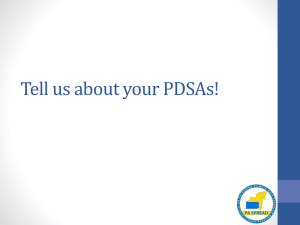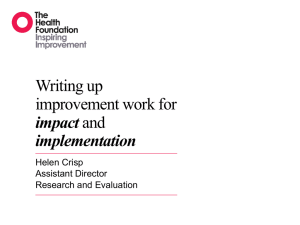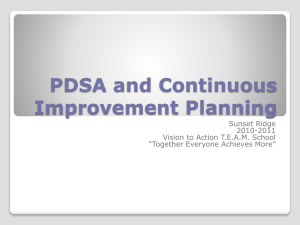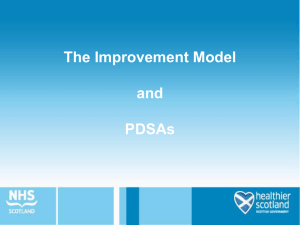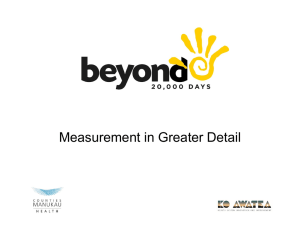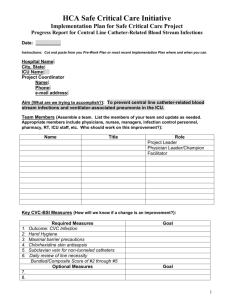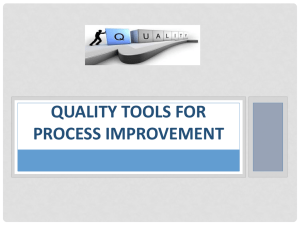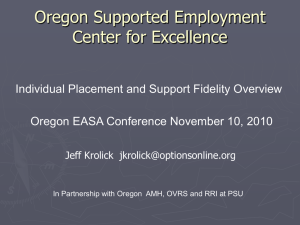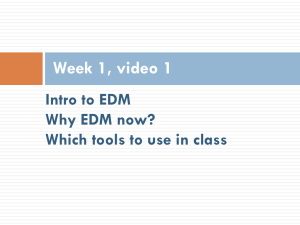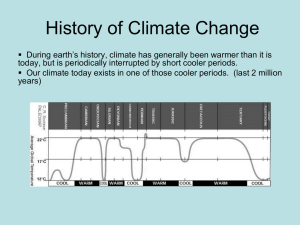Plan
advertisement
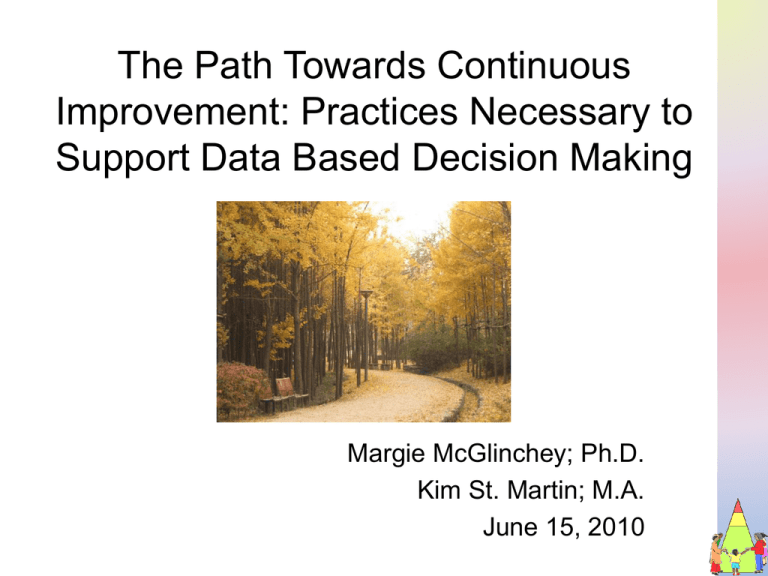
The Path Towards Continuous Improvement: Practices Necessary to Support Data Based Decision Making Margie McGlinchey; Ph.D. Kim St. Martin; M.A. June 15, 2010 Changing on Purpose • New practices do not fare well in existing organizational structures and systems Innovations and Systems EXISTING SYSTEM EFFECTIVE INNOVATIONS ARE CHANGED TO FIT THE SYSTEM EXISTING SYSTEM IS CHANGED TO SUPPORT THE EFFECTIVENESS OF THE INNOVATION EFFECTIVE INNOVATION Innovations and Systems AN ETERNAL STRUGGLE THE YIN & YANG OF CHANGE Changing on Purpose • People, organizations, and systems – Cannot change everything at once (too big; too complex; too many of them and too few of us) – Cannot stop and re-tool (have to create the new in the midst of the existing) – Cannot know what to do at every step (we will know it when we get there) – Many outcomes are not predictable (who knew!?) Improvement Cycles • PDSA (plan, do, study, act) Cycle • Rapid – Cycle – Problem Solving – Practice Improvement • Transformation Zones • PEP-PIP Cycle (policy enabled practice – practice informed policy) • Usability testing PDSA Cycles: Trial & Learning • • • • • Plan – Decide what to do Do – Do it (be sure) Study – Look at the results Act – Make adjustments Cycle – Do over and over again until the intended benefits are realized Shewhart (1924); Deming & Juran (1948); Six-Sigma (1990) PDSA Cycles: Trial & Learning David Thomas, 1985 Actual Program Ideal Program To Narrow the Variation of the Actual from the Ideal PDSA Cycles: Trial & Learning • • • • • Plan – Innovation core components Do – Selection, training, coaching Study – Fidelity, outcomes Act – Make adjustments Cycle – Do over and over again until fidelity is reached in a reasonable period of time PLAN ACT DO Innovation P A Training S P D STUDY Administration A D S P P Coaching A S D A Fidelity S D PDSA Cycle - Eternal • Plan – Coaching methods • Do – Frequency, intensity, duration • Study – Time to reach fidelity for the past 20 teachers/ staff • Act – Revise coaching methods to shore up weak areas • Cycle – do over and over again as conditions and people change forever more Transformation Zones • A “vertical slice” of an organization or system – Small enough to be manageable – Large enough to include nearly all of the relevant aspects of the current system • Operations in the TZ allow strengths and problems to “rise to the surface” – Reality-based, in the moment – Coalesce resources – human, financial and technological – for mutual benefit Transformation Zones “If you wish to make an improved product you must already be engaged in making an inferior one.” Jacobo A. Varella American Psychologist, 1977 Transformation Zones • Make use of an innovation in practice (operationalize, fidelity, outcomes) • Establish implementation supports (work on practical Drivers and Stages) • Engage leaders in the PEP-PIP improvement cycle to align system components and functions • Create capacity and momentum for larger scale changes PEP-PIP Cycle • Policy enabled practice (PEP) • Practice informed policy (PIP) The PDSA cycle in slow motion • Monthly instead of hourly, daily cycles • Bigger issues where agreement (issues, solutions) and certainty (if this, then that) are not apparent Implementation Teams Practice Informed Policy (PIP) “External” Leadership Policy Enabled Practice (PEP) System Change Management Team Usability Testing • Getting ready to scale up in a Transformation Zone • The use of larger samples under more representative conditions • Test the innovation with a more diverse group • Test the implementation methods with a more diverse group Usability Testing • 4 or 5 “typical users” to try out the current version of the implementation methods and the innovation • Fix the problems from the first “trial” • Repeat with a new group of 4 or 5 typical users • Fix the problems form the second “trial” • After 4 or 5 “trials” you should have most of the problems solved Usability Testing • Each “trial” finds about 80% of the problems with that version • Fixing the problems is a problem – is it the innovation or implementation? – That is why fidelity data are so important (the “do” part of the PDSA cycle) – High fidelity and poor outcomes = an innovation problem – Low fidelity = an implementation problem Activity Worry • Discuss with the person next to you • What specific concerns you have regarding the need for improved behavior and reading skills at your school • Write down two “worries” you discussed with your partner relating to PDSA Cycles and your districts plan for changing on purpose • Share your concerns with the table Wonder • Will your data/evidence validate your concerns? • How will PDSA Cycles work to assist you in developing the next “right” steps Back to the Building… Let’s shift focus to systems we have in place at the building to embed data based decision making into our continuous improvement cycles for reading. Evaluation of Core/Strategic/Intensive Reading Programs Assuming we share a common goal of teaching all students to read… 1. Are we developing reading support systems for all students? 2. Are we improving reading outcomes at each grade level and across time? As the building leadership team, we have three tasks: 1. Answer the question about how we are doing across the whole school and across time-at all tiers, for all students. 2. Identify improvements to celebrate with the staff 3. Identify what systems and procedures need to be in place to support each grade level in the development of a collaborative plan to address the needs of each and all students. First: The Celebration! Review student performance data at every grade level. – Is there an upward trend from fall to winter to spring? – Across years, is there an upward trend? Do we have more successful students this year than we did last year? (“goesupness”Roland Good) A good goal for the Leadership team would be to identify something positive to celebrate at each grade level. Activity • With your partner discuss the following questions: – What information if any, is typically shared at each grade level in celebration? – What does the celebration consist of? • Who?, What?, When?, Where? – Is the information integrated with your School Improvement Plan and evaluation of your School Improvement Plan? Setting Our Sights on Bigger Goals Through the Problem Solving Process ✔ Problem Identification Problem analysis Plan Implementation Plan Evaluation Problem Identification – What are the standards? (goals, benchmarks, etc.) – What is the actual performance? – Is the performance acceptable? – Example: • Histograms MiBLSi Cohort 4: Middle-of-Year Kdg Phoneme Segmentation Fluency* *Missing Data 62% (n=908) Low Risk 23% (n=342) Some Risk 14% (n=207) At Risk Questions: 1.What is the instructional priority? Phonemicare awareness skills of 35 correct sounds 2.How we doing? per minute by Spring Setting Our Sights on Bigger Goals Through the Problem Solving Process ✔ Problem Identification ✔ Problem analysis Plan Implementation Plan Evaluation Problem Analysis • Are we confident that the results are accurate? • Why is the problem occurring? • What else do we need to know about the discrepancy between the goal and the outcome? • What information will be used to answer the questions? • Summary of Effectiveness • PET-R curriculum maps, goals, delivery of instruction, management etc. Setting Our Sights on Bigger Goals Through the Problem Solving Process ✔ Problem Identification ✔ Problem Analysis ✔ Plan Implementation Plan Evaluation Plan Implementation • What needs to happen differently so that more students are reaching our reading goals at each grade level? • What are the implications for resources, professional development needs, instructional priorities, intervention, communication? • What information would be used to answer the questions? – PET-R – Current hypotheses – Summary of Effectiveness Student Data – Your current action plan Setting Our Sights on Bigger Goals Through the Problem Solving Process ✔ Problem Identification ✔ Problem analysis ✔ Plan Implementation ✔ Plan Evaluation Plan Evaluation • How and when will implementation of the plan and effect of the plan be evaluated? • What information will the team use? – Results and plans from grade level team meetings – Progress monitoring assignments and results Progress Monitoring Assignments and Progress Review Making progress Continue Instruction Not making progress Revise Instruction PDSA Cycles: Trial & Learning • • • • • Plan – Decide what to do Do – Do it (be sure) Study – Look at the results Act – Make adjustments Cycle – Do over and over again until the intended benefits are realized Shewhart (1924); Deming & Juran (1948); Six-Sigma (1990) Activity – What data will be reviewed by your school team evaluate progress? – What actions will the school leadership team take to increase student achievement? (PD, intervention) – What support is needed at grade level meetings to maximize their effectiveness and efficiency ( How often? Action plans?) – How will this information be used to support, and integrate with your School Improvement Plan? A Continuous Loop Grade Level Teams Inform School Leadership Policy School Leadership Grade Level Team School Leadership Team Enables Planning at Grade Level Effective Data Driven Meetings (EDM’s): Building Level Why Data-Driven Meetings • All staff have a stake in the relentless focus of designing instructional and intervention plans so all students can effectively learn • Use of a standard protocol for reviewing data, establishing goals and objectives, strategies, and actions is essential for continuous improvement Pairing Language and Terms • Professional Learning Communities (PLCs) and Effective Data Driven Meetings are one in the same • Both involve: – – – – Collaboration Data Focus on critical skills Systematic procedures for monitoring student progress – Action oriented Problem Solving at Multiple Levels MDE/MiBLSi Leadership Regional Technical Assistance ISD Leadership Team LEA District Leadership Team Building Leadership Team Building Staff Students Each level of the MiBLSi system can use the Continuous Improvement Process to improve the support structure below it. “Begin with the End in Mind” Covey, 1989 Activity •While watching the EDM role play, please look for: –Pre-skills necessary that allowed the EDM to be successful –Focus –Similarities and differences from what you currently experience Did Your List Look Like This? • • • • • Meeting mechanics Norms Clearly defined roles and responsibilities Focused on data Understanding of an analysis of data prior to attending the meeting • Understanding of critical skills for focus and interventions to support skill development • Action plan Purpose of Collaboration “Members of a professional learning community recognize they cannot accomplish their fundamental purpose of high levels of learning for all students unless they work together collaboratively. The collaborative team is the fundamental building block of a PLC.” DuFour, DuFour, Eaker, & Many, 2006 Climate of a Collaborative Team • • • • • • Celebrative Focused on mission Action-oriented Risk-taking Accountable Supportive (data is not used to punish) Before Grade Level Meetings • Share data with staff at least a week before meeting so that grade level teachers have an opportunity to think about and process the data. • Develop and distribute an Agenda • Make sure all individuals related to supporting grade level instruction are invited. Expectations of a Collaborative Team • • • • • Agenda – roles and responsibilities Norms – agreements and commitments Goals/Objectives – be SMART Data – use for decision-making Action Plan – written, reviewed, and revisited Four Essential Questions • What is it we want our students to learn? • How will we know if each student has learned it? • What will we do when some students do not learn it? • How can we extend and enrich the learning for students who have demonstrated proficiency? Agenda • Always have an written agenda, distributed well before the meeting. • The agenda should contain roles & responsibilities from action plan of previous meeting. Examples of EDM Agendas Fall Benchmark EDM • Establish/Review Team Norms • The Core Program and the Big Ideas – What skills are critical at this point in the school year for your grade level? – What does your data say (histograms) – Are adjustments needed to our core program? – Are there any materials/training/support necessary for the core program? – Action Plan Fall Benchmark EDM • The At-Risk Learners (30 minutes) – Who is at-risk (DIBELS Class List Reports to identify students) – How much growth is needed and by when? – Identify at-risk learners whose difficulty in reading causes an increase in misbehavior – Action Plan for Support • Students that have similar needs are placed in the appropriate instructional group with the appropriate intervention program • Address behavioral challenges concurrently with academics Tips for Establishing Norms • • • • • • • Create own State as commitments Review frequently Evaluate semi-annually Focus on a few Address violations Establish a Parking Lot Roles/Responsibilities: Critical Piece in the Process • Moderator – facilitates meeting content and flow according to agenda • Norms monitor – ensures adherence to the agreed upon meeting commitments • Time keeper – keeps meeting moving toward action plan • Data keeper – organized individual who makes sure the appropriate data is available • Scribe – takes notes during the meeting especially regarding action plan Activity • After seeing example EDM agendas, identify a grade level to begin this process • Develop an agenda that will be used for the meeting • Who will facilitate establishing norms for your grade level meetings? • Identify roles and responsibilities Grade Level Supports on Website Considerations • Using data for decision making involves complex skills and trusting relationshipsboth are equally important • Make sure you have knowledgeable individuals who can analyze data • Make sure you create a safe environment • The more you know, the more you can support • Remember the Implementation Drivers! Activity • How will the Building Leadership Team communicate and support the planning work that needs to happen at each grade level? • How will the results of each grade level meeting be communicated to and monitored by the Leadership team? Next Steps • It is helpful to have a guidance document for getting started in the beginning of the year • Checklists help you remember important things in the midst of multiple competing activities, like launching a new school year! Activity • Take a few minutes to review the checklist for starting the year right… • Would any of these steps on the checklist help to address your “worries” Thank You! Margie McGlinchey, Co-director Michigan Integrated Behavior Learning Support Initiative (MiBLSi) margiemcglinchey@mac.com Kim St. Martin, MiBLSi Lead Technical Assistance Provider kimstmartin@me.com MiBLSi Website: http://www.cenmi.org/miblsi/Home.aspx
